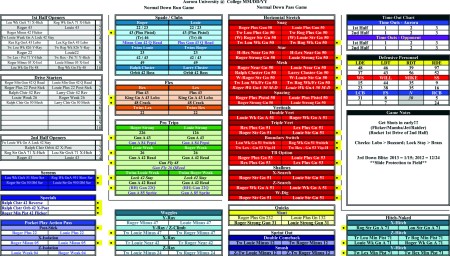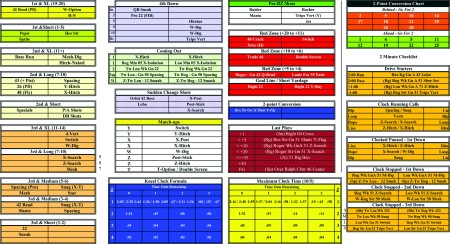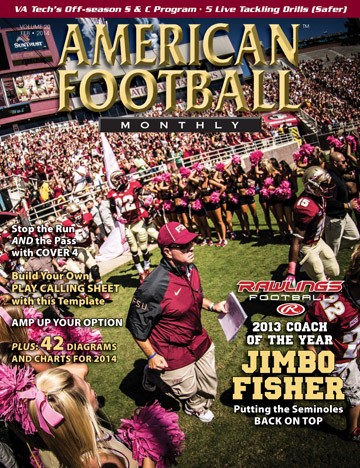Cheat Sheets - Making the Most Out of Your Play Calling System
by: Matt KalbOffensive Coordinator and Quarterbacks Coach, Aurora University©
More from this issue
A customized game call sheet can be a coaches best friend in tense game situations.
When I first became an offensive coordinator, one of the biggest challenges I faced had nothing to do with which personnel I wanted to use, what plays I would call, or even what the opponent looked like. Rather, it was the format I was going to use for my game call sheet. My “grooming” for this position was not from coaches that liked to organize their calls. One coach called the plays based on feel. Another had been coaching for so long that all he needed was a sheet of paper with the list of plays on it. Neither of these formats helped a first-time play-caller like myself.
The first thing I did was call everyone I knew and began collecting as many different forms as I could get my hands on. Rarely did I ever find two forms exactly alike, and in most cases, they weren’t even close. I started with nothing but now had an over-abundance of information to sort through.
Once I figured out what information I would need during games, I had to simply decide on the style I liked best. The sheet I use today is not much different from the one I started with, except for one major item – my current game call sheet has less on it.
To begin, I break my call sheet up by sides. I use a legal sheet of paper and print on both sides. The front side is my base side. It has our run plays listed by personnel/formation and pass plays by concept. Also, on the front side are my openers, defensive personnel, time out chart, and game notes. I color code everything to help separate categories. Here are some points for the front side of the sheet:
• I will have the formation and play for the left hash in the first column and the flip formation and play from the right in the second column.
• In the game notes section, I would include any checks that we have for the week; particular match-ups we may want to take advantage of, tempo notes or perhaps protection notes (e.g., a reminder to slide a certain way or add a RB in certain situations).
• The Defensive Personnel portion is for the jersey numbers of the opponent’s two-deep. That way, if the game notes say to attack #3, I can remember that #3 is the back-up left cornerback.
• The Normal Pass Game section is divided by pass type. There are three sections in red which are all different kinds of drop back (5-step) passes (Horizontal Stretch, Verticals, and Shallows). Then there is the Hitch-Naked section and some weeks there will be a Quick Pass or Sprint Out section. All of these will have the formations (with possible motion) and protection number listed in the two columns the same way they are listed in the opening script.
• In our play calling, we will call the formation, a play number and a play tag. Under the Hitch-Naked heading, the next line would say “Shark” for example, which is a hitch-naked route. Underneath “Shark” would be the left hash formation and number and right hash formation and number for Shark. If we can run the play from more than one formation, that would be listed as well before getting to the next hitch-naked concept. All of our passing routes are listed this way.
On the back side of the game call sheet are all of the situations we can face in the game. In the first column, I put all of my non-base down and distance calls. The second column has my fourth down calls, coming out calls, and sudden change shots, as well as a match-up column that I use to get a certain player the ball if I he hasn’t had enough touches.
Click the image below to download the Call Sheet PDF


The third column is my score column – pre-red zone shots, red zone calls, goal line calls, and final plays. At the very bottom of the second and third column I place a kneel chart and a maximum clock chart. The fourth column has my two-minute calls and a two-point conversion chart. All of the columns are divided in half so I can list each play from the left and right hashes. Here are some additional points on the second sheet:
• By Coming Out, I am referring to the field zone from -1 to -10. We have a definite plan of attack whenever we get backed up.
• The match-up title has been adjusted a little over the years. It started out being what I now list in game notes. Now I use this list as a reminder of ways to get a certain player the ball. For example, we had an All-American tight end this past year, and if I realized that he hasn’t touched the ball by the end of the first quarter, I will call one of the plays listed where he would be the primary read. The receiver positions (Y/X/W/Z) have two rows each. The first row is for possession routes (5 yards or so) and the second row is for deeper routes or home run shots.
• The Kneel Clock formula took some time to figure out. I began with the assumption that a QB kneeling the ball will take two seconds. So on fourth down with the game clock stopped at :02, I believe we can snap it, step back and then kneel on it to get :00. The opponent uses his last time out after second down, then the kneel for third down will take :02, plus :39 seconds of play clock time, plus another :02 kneel would equal :43 in the third down/0 timeout box.
• All first down boxes (0/1/2/3 timeouts) have three times listed. The higher clock time would be if the offense gained a first down and got a full 40-second play clock. The middle number would be for an out of bounds play or a measurement that would result in a :25 second clock. The lowest time is for a dead ball where the clock would start on the snap. How I use it is simple - if the clock is under the time listed in the situation box, we can kneel it out. If not, then we have to run a play.
• The Maximum Clock formula is the same as the Kneel Clock formula except that now I assume we can burn :04 seconds per play by running the ball wide without going out of bounds.
While it’s an ever-evolving process – and I learn something new each week – this system really works for me.







